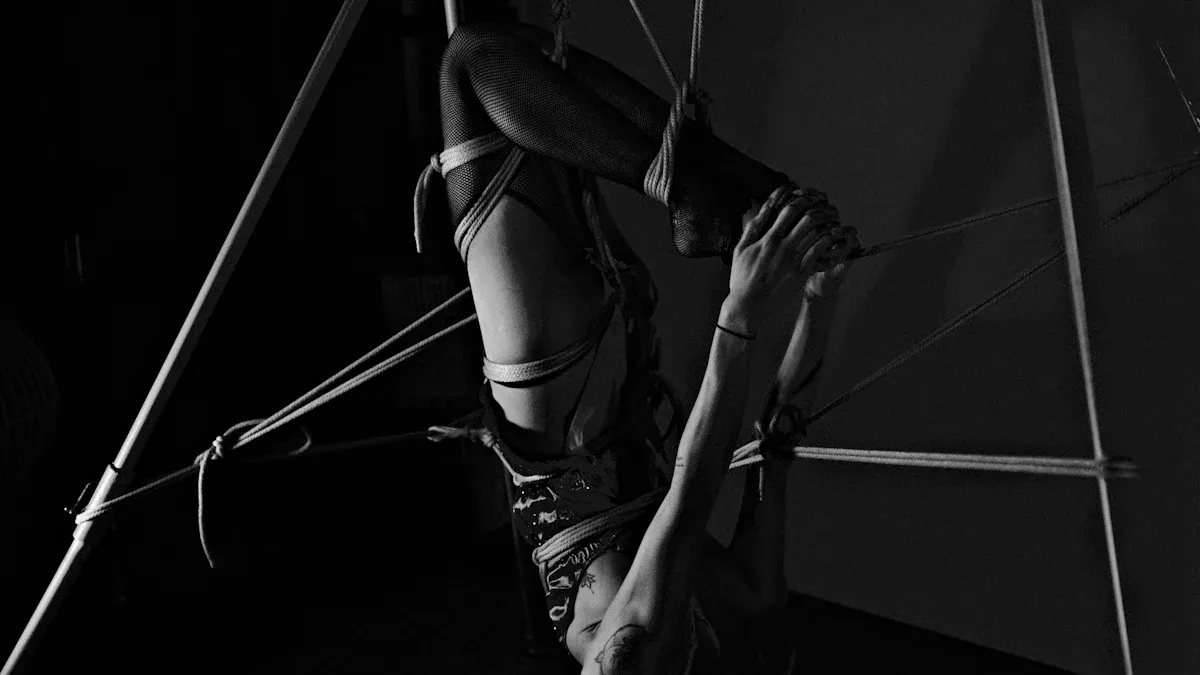
You may know bondage as the act of restraining a partner during intimate play. In BDSM, this can serve many purposes such as creating erotic tension, exploring trust, or enjoying aesthetic forms. Research finds that a large number of people have experience or interest in bondage, with up to 69% reporting related fantasies. The BDSM community values consent and safety, using clear rules and communication to protect everyone involved. These practices help you explore boundaries and psychological needs in a secure way.
Key Takeaways
-
Bondage in BDSM is about trust, consent, and exploring new sensations safely with your partner.
-
Clear communication and agreed safe words are essential to set boundaries and keep everyone comfortable.
-
Start with simple tools and light bondage, building skills and trust before trying advanced techniques.
-
Always prioritise safety by checking equipment, having quick-release options, and practising aftercare together.
-
Aftercare supports emotional and physical recovery, helping partners feel valued and connected after play.
Bondage in BDSM
What is Bondage?
You may see bondage as the act of restraining someone’s movement using items like cuffs, ropes, chains, or even soft fabrics. In BDSM, bondage means you and your partner agree to use these restraints for pleasure, trust, or sensory play. People often enjoy the feeling of being held in place or the excitement of giving up control. Some find the look of ropes or cuffs beautiful, while others focus on the sensations or the trust built between partners.
Researchers have found that the best way to understand bondage is by listening to people who practise it. They use interviews and observations to learn about personal feelings and social experiences. These studies show that consent and communication are always at the centre of bondage. You and your partner might set up agreements or use safe words to make sure everyone feels secure. Unlike some other activities, bondage in BDSM is not about harm or danger. Instead, it is about exploring new feelings in a safe and respectful way.
Note: Bondage can take many forms, from simple handcuffs to complex rope patterns. What matters most is that you and your partner agree on what feels right and safe.
Roles and Dynamics
When you take part in bondage, you often choose roles. The most common roles are dominant and submissive. The dominant partner usually takes control, deciding how and when to use restraints. The submissive partner gives up control and allows themselves to be restrained. However, these roles are not always fixed. Sometimes, the person being tied up may guide the scene by telling the dominant what they want. This is called "topping from the bottom".
Surveys and studies show that these roles are more about who leads the activity than about physical actions. For example, you might hear the terms "top" and "bottom". In some cases, "top" means the person doing the tying, while "bottom" means the one being tied. In other cases, these words describe who has control, not just who is active or passive.
A large survey in Australia found that people who practise BDSM, including bondage, come from many backgrounds. They often enjoy a wide range of activities and do not show higher levels of distress or mental health problems. In fact, men who take part in BDSM often report lower stress than those who do not. Another study found that people who like to be submissive in bondage may also show some submissive traits in daily life, but this is not always true. Many people switch roles or try different things depending on the situation.
You can see that roles in bondage are flexible. You and your partner can decide what works best for you. The most important thing is that everyone agrees and feels comfortable.
Types and Tools

Rope and Shibari
You might find rope one of the most popular tools in bondage. Shibari, a Japanese style of rope bondage, has a rich history. It began as Hojo-jutsu, a martial art used by samurai to restrain prisoners in Japan’s Muromachi and Sengoku periods. Over time, this practice changed. It became an art form called Kinbaku, which focused on beauty and emotion. Artists like Seiu Ito helped shape modern Shibari by adding elements from kabuki theatre and Japanese art.
Shibari uses natural fibre ropes, often jute or hemp. The person who ties is called a rigger, and the person being tied is the rope bottom. You can see Shibari in performances or use it for private play. The process is slow and careful, building trust and connection. Many people enjoy the patterns and the feeling of being held. Shibari can also increase sensation and intimacy.
Tip: Always check the rope for rough spots before you start. Soft, clean rope feels better on the skin.
Cuffs, Chains, and Other Restraints
You may want to try cuffs, chains, or straps if you prefer something simple or quick. Cuffs often use soft materials like leather or padded fabric. They close with buckles or Velcro, making them easy to put on and take off. Chains and metal restraints feel heavier and colder. Some people enjoy the extra weight and the sound they make.
Other options include spreader bars, tape, or even scarves. Each tool gives a different feeling. You can choose what matches your comfort and style. Remember, you should always have a way to release restraints quickly in case of emergency.
|
Tool |
Material |
Features |
|---|---|---|
|
Cuffs |
Leather, fabric |
Soft, adjustable |
|
Chains |
Metal |
Heavy, secure |
|
Spreader bars |
Metal, wood |
Keeps limbs apart |
|
Tape |
Vinyl, silicone |
No knots needed |
Light vs. Advanced Bondage
You can start with light bondage if you are new. Light bondage uses simple tools like scarves, soft cuffs, or gentle rope ties. These methods let you test what feels good and safe. You can talk with your partner and set clear limits.
Advanced bondage includes more complex ties, suspension, or combining different restraints. This level needs more skill and practice. You must learn about safety and body awareness. Some people train for years to master advanced techniques.
The BDSM community recognises three main identity types: Dom-type (dominant), Sub-type (submissive), and Switch (someone who changes roles). These roles help you decide who leads and who follows during bondage play. Research shows that these identities are healthy and based on consent.
Note: Start slow and build trust. You can always try new things as you gain experience.
Safety and Consent
Communication and Boundaries
You need clear communication before you start any bondage play. You and your partner should talk about what you want, what you do not want, and what feels safe. This conversation helps you set boundaries. Boundaries are the limits that keep you comfortable and safe. You can use a checklist or just talk openly. Some people write down their limits, while others prefer to discuss them face to face.
Good communication builds trust. You feel more relaxed when you know your partner listens to you.
You should check in with each other before, during, and after the scene. This helps you both feel secure and respected. If you feel unsure or want to stop, you can always speak up. Your feelings matter at every stage.
Safewords and Signals
Safewords are special words you use to pause or stop the activity. You and your partner agree on these words before you begin. Many people use the traffic light system:
|
Safeword |
Meaning |
|---|---|
|
Green |
Everything is fine, keep going |
|
Yellow |
Slow down or check in |
|
Red |
Stop immediately |
You can also use hand signals or objects if you cannot speak. For example, you might drop a ball or snap your fingers. Safewords and signals give you control, even when you are restrained. You should never ignore a safeword. When someone uses it, you must stop and check in right away.
Physical and Emotional Safety
You need to think about both physical and emotional safety in bondage. Always use safe equipment and check it before you start. Make sure you can release restraints quickly in case of emergency. Avoid tying too tightly or near joints and nerves. Keep scissors or a safety tool nearby.
You may feel many emotions after a scene. Some people feel happy or excited, while others feel tired or sad. This is normal. Aftercare helps you recover. Aftercare means you and your partner support each other after the activity. You might cuddle, talk, or just sit quietly together. Both Dominants and submissives need aftercare, as everyone can feel strong emotions.
-
Aftercare gives you emotional, psychological, and physical support.
-
You may feel euphoria, sadness, or even depression after a scene, so aftercare should fit your needs.
-
Both partners benefit from aftercare, no matter their role.
-
Trust and communication before, during, and after the scene help you feel safe and recover well.
-
Common aftercare includes hugging, verbal support, and talking about what happened.
Psychological research shows that self-reflection and open communication help you process your feelings. Aftercare is not just about physical comfort. It also gives you reassurance and helps you understand your emotions. You should talk about aftercare needs before you start. Some people want cuddles, while others need space or a snack. You can also use this time to talk about what you liked or did not like.
Remember: Safety and consent are the foundation of all BDSM activities. You protect yourself and your partner by talking, listening, and caring for each other.
Starting Bondage Play

Beginner Tips
You may feel nervous when you try bondage for the first time. This is normal. Many people feel awkward or unsure at the start. Treat bondage as a skill that you can learn and improve with practice. Talk openly with your partner about what you want to try and what you do not want. If you find it hard to talk about your feelings or boundaries, take a step back and build more trust first. Experts say that open discussion is key for safe play. If you or your partner cannot talk about safety or safe words, you may not be ready.
Tip: Mistakes can happen. You should see them as part of learning, not as failure.
Choosing Equipment
Start with simple and safe tools. Soft cuffs, scarves, or beginner rope kits work well. Avoid anything that can tighten on its own, like zip ties. Always check that you can release restraints quickly. Keep safety shears nearby in case you need to cut something fast. Before you buy equipment, read reviews or watch tutorials from trusted sources. Many experts suggest learning from books, classes, or videos before you try advanced techniques.
|
Equipment |
Pros |
Cons |
|---|---|---|
|
Soft cuffs |
Easy to use, comfy |
May not fit everyone |
|
Rope |
Versatile, cheap |
Needs practice |
|
Scarves |
Gentle, accessible |
Can slip or tighten |
Step-by-Step Guide
-
Set the mood. Choose a quiet, private space. Talk about what you both want from the scene.
-
Negotiate limits. Discuss what is okay and what is not. Agree on a safe word, like "red" or "banana".
-
Check equipment. Make sure everything is clean and safe. Keep safety tools close.
-
Start slow. Begin with light restraint. Watch your partner’s body language and check in often.
-
Stay alert. If you see discomfort or hear the safe word, stop right away and talk.
-
Aftercare. When you finish, spend time together. Offer comfort and talk about how you both feel.
Bondage can help you build trust and explore new feelings. Many people enjoy the sense of connection and safety it brings. Studies show that nearly half of adults have fantasised about BDSM, so you are not alone if you feel curious.
Aftercare
What is Aftercare?
Aftercare means you and your partner take time to care for each other after a bondage scene. You might cuddle, talk, or share a drink. This helps you both feel safe and calm. Aftercare is not just a nice extra. It is a key part of safe and consensual BDSM. Many experts say that aftercare shows you respect each other's limits and feelings. You use it to check in, talk about what you liked, and fix any problems.
Aftercare is a sign of trust and respect. It helps you recover both physically and emotionally.
You can use different types of aftercare, depending on what you did. For example:
-
You might need to check for marks or bruises after bondage.
-
You may want a blanket, a snack, or some water.
-
You could talk about how you feel or what you enjoyed.
Workshops and guides teach that aftercare is as important as safe words or risk checks. You should plan aftercare before you start. This helps you feel empowered and supported. If you skip aftercare, you might feel sad or confused. The BDSM community sees this as a sign that something went wrong with consent.
Emotional Support
You may feel strong emotions after a scene. Sometimes you feel happy or relaxed. Other times you might feel sad or tired. Emotional support helps you handle these feelings. You and your partner can talk about what happened. You can listen and comfort each other.
Studies in therapy and nursing show that emotional support helps people recover from stress and trauma. When you have a safe space to share your feelings, you feel less anxious or ashamed. This support can improve your mood and help you sleep better. You build trust and feel closer to your partner.
Remember: Good aftercare includes both physical comfort and emotional support. You help each other feel safe, valued, and understood.
You can always adjust your aftercare. Talk about what works best for you. This keeps your experience positive and safe.
You have learned that bondage in BDSM centres on trust, consent, and safety. Experts highlight that clear communication and ongoing negotiation help you build respect and reduce stress. Consent is not just a feeling but a process you share with your partner. Take your time, explore what feels right, and remember that healthy bondage play always values your comfort and boundaries. You deserve a safe and positive experience.
If you feel curious, seek more information and talk openly with your partner. Everyone’s journey is unique.
FAQ
What if you feel nervous about trying bondage?
You might feel nervous at first. This is normal. Start with simple activities. Talk openly with your partner. Take small steps. You can stop at any time if you feel uncomfortable.
Can you practise bondage without pain?
Yes, you can. Many people enjoy bondage for the feeling of restraint or trust, not pain. You choose what feels good. Always talk about your limits before you start.
How do you clean bondage equipment?
Clean cuffs and ropes after each use. Use mild soap and water for most materials. Let everything dry fully before storing. Check for damage before you use them again.
Is bondage safe for everyone?
Bondage can be safe if you follow rules. You must talk about safety, use safe words, and check equipment. Some health conditions may make bondage risky. Ask a doctor if you have concerns.










